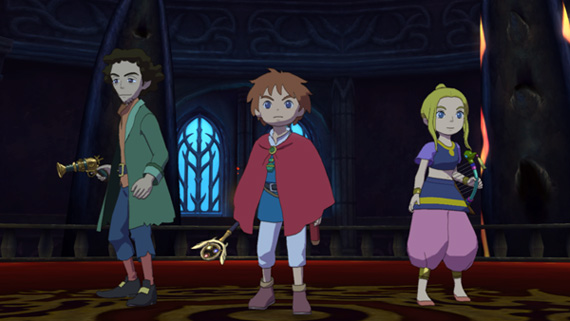
There’s a distinct language to the work of Studio Ghibli, not within a single stream of media such as the writing or the musical scoring alone, but rather in the way the visual style, narrative direction and audio join together with a unique logic that makes any and all fantastic things possible, delivering film experiences that find me still able to recall where I saw each Ghibli masterpiece for the first time – they tend to make a strong impression.
After stopping by Namco-Bandai’s booth today, I’m more certain than ever that Level-5 and Studio Ghibli have crafted all these streams into a singular symphony of wonder and delight in videogame form, and that Ni No Kuni is the only RPG you’ll need for an indefinite period of time still to be named and marked.
But just in case you’re somehow not a drooling Studio Ghibli fan, allow me to elaborate on some reasons why.

When I first started following this collaborative PlayStation 3 exclusive, one of the biggest concerns voiced by others was the improbability, not just of preserving Ghibli’s distinct style, but offering new territory in which it might shine as brightly as the studio’s films. Finally being able to move the game’s protagonist Oliver around while taking in the sights with my own eyes has verified that Level-5 has found the means to allow that visual charm to emerge within the game, but what about the rest?
The demo I played at Namco’s booth today offered two areas, a pastoral area of green hills and an ocean view, and a city apparently populated entirely by pigs. The first of these offered a chance to sample some of the combat, with bizarre and colourful creatures roaming the countryside, giving me the opportunity to sneak up on them to gain the advantage in the battle screen. From there I summoned creatures of my own to do battle, issuing commands to attack or defend – nothing out of the ordinary for a modern JRPG, and an open palette for Ghibli flavoured character creation.

What I spent far more time doing was rotating the camera, allowing me a chance to see Oliver from the front, watching as the act of running caused his mouth to open and the fabric of his cape to sway. There were many small movements helping to bring the playing to life, and while said playing could never be quite as crisp and sharp as the animated cut-scenes, it’s a close as I could have hoped, and more lively for the effort than any RPG I’ve played in recent memory. Even the lantern in the nose of Oliver’s strange companion jiggled with movement, adding some assurance that someone cared about the details.
As for the city of pigs, Oliver and company quickly found themselves in the middle of a royal procession, with a pig King and a series of large transforming structures turning a quiet street into a roaring parade route without warning.
How very Ghibli that sequence was.
The thought returned to me several times – how very Ghibli the entirety of the offering was, with me recognizing every element working to make such an impression, and entirely lost in the magic of the experience produced. If I had to put it more bluntly, I’d probably suggest that Oliver’s quest to save his mother inspires a belief that this will be that unique type of RPG where the narrative emphasis is felt by the player, wherein one finds easy means to give a damn about reaching the end. Enough of the pieces were on display to convince me that the same inviting narrative elements and characters from Ghibli’s film work emerges within Ni No Kuni.
And if that bit of my own strange language makes sense to you, then I believe you’ll also be looking forward to the game’s early 2013 release.